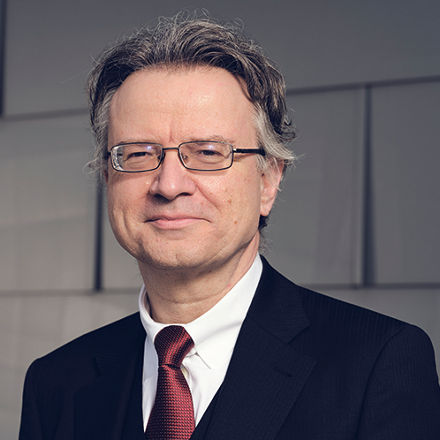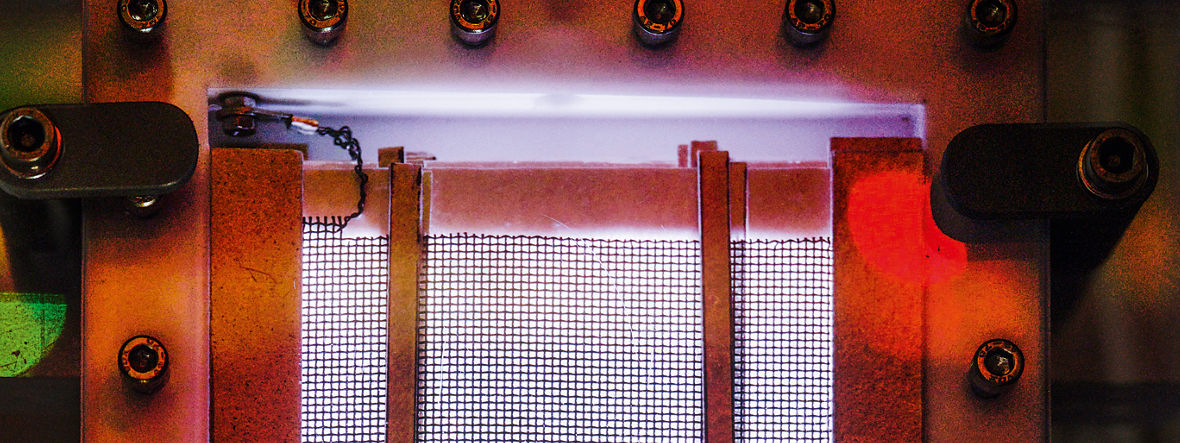Sometimes you need a cordless screwdriver to do research,” says physics professor Dr. Ronny Brandenburg as he loosens the Allen screws on a transparent plastic box lying on the workbench in front of him. A stack of metal grids can be seen inside the box. Brandenburg pulls out the last screw and lifts off the lid. “The gap at the contact is a bit too wide; maybe that’s why there was a short circuit. Pass me that wrench there, please,” he says to his colleague Dr. Ralf Jackstell, who is standing next to him at the workbench in the Rostock lab. Jackstell, a chemist, hands Brandenburg the wrench and replies with a smile, “Then it’s one to two now: You guys wrecked two units, while we only wrecked one.”
Ronny Brandenburg and Ralf Jackstell regularly tinker with equipment here in the laboratory of the Leibniz Institute for Catalysis (LIKAT)—and sometimes something breaks in the process. The small boxes are inconspicuous except for the power cable and the two connections for the gas supply, but they are surprisingly powerful. These are plasma reactors that convert the greenhouse gas carbon dioxide into valuable chemical products. Over the next three years, the experimental apparatus, which is currently the size of a box of chocolates, is to be scaled up to a large pilot plant.
Evonik has been contributing its scientific know-how from the outset, but also wants to closely support the step toward large-scale implementation. That’s because the research that is being conducted here on a small scale could take some of the most important reactions for the chemical industry to a whole new level. The word “plasma” evokes visions of outer space, of rocket science, and of suns that are many thousands of degrees hot. But here in the lab in Rostock, you quickly realize that plasmas are very down to earth. They are formed when gases are exposed to strong electric fields. The electric voltage tears electrons from the gas molecules, which collide with other molecules. This forms a reactive mixture of free electrons, ions, and molecular fragments that come together to create new molecules.
“Many people are amazed when I tell them how many everyday objects are made with plasmas,” Brandenburg says. They are found not only in plasma televisions but also in fluorescent tubes, in which they generate light. They are also used in paint shops, where components are cleaned and pretreated with plasma before the paint is applied. Plasmas are an everyday phenomenon. The reactors Brandenburg and Jackstell are working on are correspondingly simple. “It only took us about a month to build the first lab reactor,” Brandenburg says. “The real challenge lies in controlling it to do exactly what you want it to do.”
The small reactors are at the heart of the PlasCO₂ collaborative project, which is coordinated by Evonik. Brandenburg, a physicist, is a professor and the head of research for surface plasmas at the Leibniz Institute for Plasma Science and Technology in Greifswald, Germany. Jackstell is a chemist who heads the Applied Carbonylations department at LIKAT in Rostock. Another participant is the Rafflenbeul Anlagenbau company, located near Frankfurt am Main, which manufactures plasma systems for air purification. It will build the prototype when the lab phase is finished.

30 DEGREES CELSIUS INSTEAD OF 3,000 DEGREES
One of the appealing things about the PlasCO₂ project is that it uses CO₂ as a raw material. Carbon dioxide gets a lot of bad press for its role as a greenhouse gas. For some time now, work has been under way to separate it from the exhaust gases of industrial plants, cement works, and blast furnaces in the steel industry and store it in disused natural gas fields, for example. But it can also be used in the chemical industry to make new high-quality products. The problem with carbon dioxide is that it is a very non-reactive molecule. In order for it to react with other substances, it must first be activated. For example, the thermal splitting of CO₂ requires temperatures of between 3,000 and 4,000 degrees Celsius.


The energy consumption is correspondingly high. Plasma reactors would be an alternative means of making carbon dioxide reactive. All it takes to generate the plasma is electrical energy. Unlike the extremely hot plasma of the sun, which has temperatures of many thousands of degrees, PlasCO₂ is a cold plasma of less than 100 degrees Celsius. The small laboratory reactors operate at 40 watts—the power of a household light bulb. The high energy of the plasma ultimately comes from knocking out the electrons, which then trigger the chemical reactions. The PlasCO₂ team is currently testing several ways to turn carbon dioxide into valuable products.
In the plasma, high-energy electrons convert carbon dioxide and hydrogen into carbon monoxide. Together with hydrogen, this forms synthesis gas, which is an important feedstock in industry for the synthesis of higher-value hydrocarbons. Carbon monoxide (CO) is used in hydroformylation, among other things. In this process, CO and hydrogen (H₂) react with larger hydrocarbon molecules, the olefins, to form aldehydes, which are needed in the chemical industry for many downstream products: for plasticizers in plastics as well as for adhesives and lubricants. Globally, hydroformylation supplies more than 10 million tons of products each year.
FAREWELL TO FOSSIL RAW MATERIALS
Until now, the carbon monoxide required for this has been obtained from natural gas. The new plasma reactor could make CO production more sustainable. It would use carbon dioxide from industrial waste gases, while the hydrogen would be produced with the help of renewably generated electricity that splits water in electrolysis plants. This would allow synthesis gas production to be decoupled from fossil raw materials. “However, the reactor can do a lot more,” says Jackstell.
“We can create different products depending on the molecules that we allow to flow into the reaction chamber.” For example, reacting olefins with CO₂ and H₂ directly in the reactor can produce ethylene glycol and other compounds. Since the reaction of carbon dioxide and hydrogen also produces small amounts of oxygen as a byproduct, it is possible to run processes in the reactor that require oxygen—oxidative coupling, for example. “A lot of consecutive reactions start with oxygen. There are very many options,” says Jackstell. The production of synthesis gas in plasma is by no means new; it was already known back in the 1970s. However, because the production of carbon monoxide from natural gas had long been established by then, the chemical industry showed little interest in using plasma—until now.
Because of the move away from fossil raw materials, the idea of producing chemicals with green electricity in a reactor is suddenly very topical. “However, we still have to convince some of the experts of its benefits,” Jackstell says. “There is a persistent belief in the community that the chemical reactions in plasma are difficult to control. But that’s not quite true.” Many research groups have been working with large molecules in plasma for a long time, and a lot can actually happen chemically. “It’s a molecular jungle,” says Jackstell, who points out that his group’s approach is different.

"However, we still have to convince some experts of the benefits," says Jackstell. "There is an opinion in the community that the chemical reactions in plasma are difficult to control. That's not true." Many research groups have been working with large molecules in plasma for a long time, and a lot can actually happen chemically:“We work with very small molecules that can basically only react in one way,” he says. “This can be controlled very well.” In the coming months, the PlasCO₂ team will slowly work its way from small molecules to larger ones such as olefins. The reactor also has the advantage that the chemical reactions can be switched on and off at the push of a button. “It lets us produce chemicals on demand, so to speak,” says Ralf Jackstell. In the future, plasma reactors would also be of interest to small and medium-size companies, which could use them to manufacture small quantities of base materials for their production operations at any time. Carbon monoxide is toxic.
It is transported and stored in gas cylinders, and the people who handle it have to observe strict safety standards. In the future, the reactor could be used to produce it in small amounts in precise doses—and use it immediately. At LIKAT, Ronny Brandenburg, Ralf Jackstell, and their colleagues have set up the entire production chain in miniature: the reactor, the gas supply, a collection vessel for the various products, and a reaction vessel in which they process the products into various chemical compounds. An FTIR infrared spectrometer, which measures which compounds come out of the reactor, is also connected to it.

The reactor itself consists of millimeter-thick grids stacked on top of one another. These grids are alternately connected to the positive and negative poles and there is always a dielectric between them. To start the reactor, an electrical voltage of about 8,000 volts is applied between the positive and negative poles. The chemical reactions take place in the wafer-thin gaps between the dielectric and the electrode grids. The trick is to match up everything perfectly: the distances between the grids, the frequency at which the alternating current oscillates, and the voltage. Any unevenness in the grids changes the spacing, the reactor performance, and the physical parameters; that’s why the stack must be arranged perfectly.
INTERDISCIPLINARY TEAMWORK
Ronny Brandenburg turns a knob in the darkened laboratory. He’s controlling the voltage. “It’s 4,000 volts, so the reactor should ignite right away,” he says. Indeed, the dark reactor surface brightens and takes on a bluish hue. There’s no flame and no flickering—just a steady glow. The reactor is up and running. “It’s at 40 watts, full power,” says Brandenburg’s research colleague Jackstell. It doesn’t always work right away. Sometimes a capacitor causes problems, sometimes a contact. Sometimes the output suddenly drops to zero. When that happens, it means the reactor was overloaded. As ambitious researchers, Brandenburg and Jackstell accept all of this, because failures always provide insights into what can be improved. “We really like working together,” says Jackstell. “Although chemists and physicists generally speak different scientific languages, we like to jointly conduct the experiments.”
Professor Robert Franke, who heads PlasCO₂ at Evonik, is also enthusiastic about the results of the interdisciplinary collaboration. “The team in Greifswald and Rostock has developed incredible momentum,” he says. PlasCO₂ emerged rather accidentally from a predecessor project. At that time, Ralf Jackstell’s research group at LIKAT was investigating whether cold plasma could be used to modify and optimize catalysts. Carbon dioxide and hydrogen were used in these experiments. “At some point, we noticed quite incidentally that the yield of synthesis gas was considerable,” says Robert Franke. That’s how the idea for the new project PlasCO₂ was born. “I’m fascinated by the idea of using a relatively simple technical setup to manufacture complex chemical products,” says Franke. “It’s a really fascinating future-oriented technology.”
THE PLASCO₂ PROJECT
The PlasCO₂ project is developing plasma reactors that convert carbon dioxide into carbon monoxide (CO) and hydrocarbons. When CO is combined with hydrogen, it yields synthesis gas, which is required for the production of many basic chemical substances—in particular the production of aldehydes via hydroformylation. Four partners from industry and research are working together on the project: the Leibniz Institute for Catalysis (LIKAT) in Rostock, the Leibniz Institute for Plasma Science and Technology (INP) in Greifswald, and the companies Rafflenbeul Anlagenbau and Evonik. The project is receiving €1.8 million in funding from the German Federal Ministry of Education and Research (funding code b 33RC030). Evonik is responsible for the overall coordination of PlasCO₂.

»If everything goes well, we’ll be able to do chemistry at the push of a button in three years«
Robert Franke HEAD OF HYDROFORMYLATION RESEARCH AT EVONIK
A circle closes
Franke has long pursued the idea of doing chemistry in cold plasma. In the early 2000s he started a project at Creavis, Evonik’s strategic innovation unit, in which an important step was the production of ozone. The ozone was used to produce dicarboxylic acids via a process known as ozonolysis—for example, suberic acid, which is required for the production of polyamides and polyesters. The ozone can be obtained from oxygen by various means, including a corona discharge or in a cold plasma. “The plasma reactor had comparable yields and was absolutely technically feasible, though not economically competitive at the time,” says Franke. As a reminder of the project, Franke still has a glass jar of suberic acid powder on his office shelf. The circle is now closing, thanks to the PlasCO₂ project. The team plans to go a step further in the months ahead. “We want to find out whether we can have other reactions take place in the reactor when the dielectric and the electrode grids also act as a catalyst,” says Jackstell. “For example, we can use catalytic metals, such as cobalt.” This opens up many additional opportunities, according to Franke.

“For example, the process could be used to produce carboxylic acids directly in the reactor from ethylene,” he says. The metal palladium, with which the group at LIKAT is very familiar, could be used as a catalyst. “If everything goes well, we’ll be able to do chemistry at the push of a button in three years,” Franke says. In order to produce larger amounts, the throughput could be increased by running multiple reactors in parallel. “It would be a truly sustainable solution if it was powered by green electricity and green hydrogen,” says Franke. But until that time comes, the researchers will still need to pick up their cordless screwdrivers quite often to get defective reactors ready for the next test.


